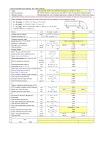BUILDING A MODEL WITH CAESAR - II
Engineers nowadays do not have to worry about solving higher degree, or differential equations to perform complicated calculations, because they can create complete models of the system they are trying to design and analyses and let the software perform the analysis for them. However as the saying goes, "Garbage in : Garbage out " the engineer still has to possess good engineering judgment to know what to expect from a computer analysis and how to interpret the output.
Although there are various software available to do pipe stress analyses, Caesar II is one that is well know an frequently used for the oil and gas engineering analyses.
USING CAESAR II FOR PIPE ANALYSIS
CAESAR II is most often used for the mechanical design of new piping systems. Hot piping systems present a unique problem to the mechanical engineering these irregular structures experience great thermal stain that must be absorbed by the piping supports, and attached equipment. These" Structures " must be stiff enough to support their own weight and also flexible enough to accept thermal growth. These loads, displacements, and stresses can be estimated through analysis of the piping model in CAESAR II . To aid in this design by analysis, CAESAR II incorporates many of the Limitations placed on these systems and their attached equipment. ASME Section VIII, and the welding research council or by manufactures of piping related equipment (API, NEMA, or Expansion joint manufacturers association - EJMA).
CAESAR II is not limited to thermal analysis of piping systems. CAESAR II also has the capability of modeling and analyzing the full the full range of static and dynamic loads, which may be imposed on the system. Therefore, CAESAR II is not only a tool for new design but it is also valuable in troubleshooting or re-designing existing systems. Here, one can determine the cause of failure or evaluate the severity of un- anticipated operating can determine the cause of failure or evaluate the severity of un- anticipated operating conditions such as fluid/piping interaction or mechanical vibration caused by rotating equipment.














0 Comments